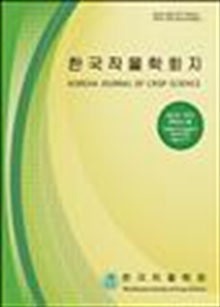간행물
한국작물학회지 KCI 등재 Korean Journal of Crop Science

- 발행기관 한국작물학회
- 자료유형 학술지
- 간기 계간
- ISSN 0252-9777 (Print)2287-8432 (Online)
- 수록기간 1963 ~ 2017
- 주제분류 농수해양 > 농학 농수해양 분류의 다른 간행물
- 십진분류KDC 524DDC 633
권호리스트/논문검색
제 59권 3호 (2014년 9월) 23건
21.
2014.09
서비스 종료(열람 제한)
The rice stem borer (Chilo suppressalis Walker) was one of the most destructive pest of rice for the 1960s and 1970s in Korea. Recently, it is newly recognized as a potential risk factor to the biomass yield of bioenergy crops. The current research was firstly conducted to investigate overwintering larvae population density and pattern of rice stem borer attacking Miscanthus sacchariflorus cv. Geodae 1 which is referred to as an ideal lignocellulosic bioenergy crop in Korea. Population density of larvae per 1 m2 in stems and rhizomes at the Miscanthus experimental plots and rates of damage (wormhole, abscission) of M. sacchariflorus cv. Goedae 1 were investigated from October 2012 to March 2013. The population of larvae per 1 m2 in stems of Miscanthus were 23, 4, 1, and 1 in October, November, December 2012, and January 2013, respectively. Over the same period, the population of larvae in basal stem rots and rhizomes were increased, whereas decreased in stems. Interestingly, the positions of larvae for overwintering in Miscanthus were confirmed to 5~10 cm below the soil surface such as basal stem rot and rhizome, whereas the most common overwintering position known in rice is a part of stem on the ground such as rice straw and rice stubble. It would suggest that the larvae gradually moved to bottom of stems and rhizomes in soil in line with decline in temperature. Moreover, the damage rates of stems per 1 m2 were up to more than 50% in some places. In conclusion, this might be the first report that rice stem borer could affect the productivity of biomass of Miscanthus in case of mass cultivation. Moreover, it should be necessary to make a decision in insect control management for this bioenergy feedstock and other related crops.
22.
2014.09
서비스 종료(열람 제한)
Kenaf (Hibiscus cannabinus L.) was recognized as a potential source of forage. But the domestic cultivation techniques are not set standards yet. So we tested the basic culture techniques during 2012~2013 for getting a high yield and good grade forage production system. The best seeding method for mechanized planting (corn planter used) was hill seeding with 20×20 cm seeding distance. When we treated hill seeding with 20×20 cm, the yield what we could get was 13,641 kg/10a and it was 32% more than that of conventional practice hill seeding with 20×30 cm seeding distance. The proper seeding date for getting high yield was May 1. In May 1, the yield per 10a was reached 13,423 kg, and it was 30% more than that of seeding at May 30. More over the crude protein content which was important factor for determinating forage nutritive value was 12.7% and it was higher 1.8% (relatively 16.5% high) than that of May 30 seeding. The most effective herbicide for kenaf was Fluazipof-p-butyl. It’s herbicidal rate was 97% and phyto-toxicity was less than 5%. Regional adaptability for Jeollabuk-Do including Imsil Gun, Kochang Gun and Sunchang Gun were identified that the stable cultivation were possible in these area with average yield 12,400 kg/10a and it was about 1.7 times as compared to corn harvest.
23.
2014.09
서비스 종료(열람 제한)
Flavonols as a major kind of plant secondary metabolites are known for health-promoting compounds in onions (Allium cepa L.). The objectives of this study are to determine profiles of flavonol glycosides in different 75 onion accessions. A total of five flavonols (quercetin 3,4'- diglucoside, Q34'diG; quercetin 3-glucoside, Q3G; quercetin 4'-glucoside, Q4'G; isorhamnetin 4'-glucoside, I4'G; quercetin, Q) were identified from onion accessions. In positive ion mode using LC-ESI-MS, individual flavonols were confirmed from one and two glycosylation binding with aglycone such as quercetin and isorhamnetin. Total flavonol contents were distributed in white onion (range of 0.18-6.47 mg/g DW) and purple onion accessions (range of 2.39-6.47 mg/g), respectively. The mean of flavonol contents in purple onion (4.41 mg/g) showed 1.4-fold higher than white onion (3.23 mg/g). The Q34'diG and Q4'G were considered as the major compounds of flavonol glycosides in onion accessions.
1
2

